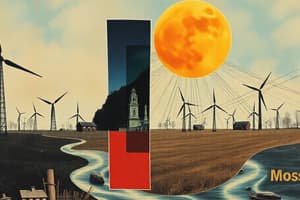Podcast
Questions and Answers
What are the main types of renewable energy mentioned in the text?
What are the main types of renewable energy mentioned in the text?
The main types of renewable energy mentioned are solar, wind, hydro, geothermal, and biomass energy.
How do renewable energy sources compare to fossil fuels in terms of greenhouse gas emissions?
How do renewable energy sources compare to fossil fuels in terms of greenhouse gas emissions?
Renewable energy sources produce little to no emissions during operation, while fossil fuels release carbon dioxide when burned.
What challenges are associated with the transition to renewable energy?
What challenges are associated with the transition to renewable energy?
Challenges include high initial investment costs, technological limitations, and the intermittent nature of some sources like solar and wind.
Why is it important for nations to invest in renewable energy?
Why is it important for nations to invest in renewable energy?
In what ways can countries enhance their transition to renewable energy?
In what ways can countries enhance their transition to renewable energy?
Flashcards
Renewable energy
Renewable energy
Energy derived from natural sources that replenish constantly, like solar, wind, hydro, geothermal, and biomass.
Climate change
Climate change
A major global issue caused by greenhouse gas emissions, leading to rising temperatures and extreme weather events.
Harnessing renewable energy
Harnessing renewable energy
A solution to climate change that aims to reduce greenhouse gas emissions by using renewable energy sources.
Greenhouse gas emissions
Greenhouse gas emissions
Signup and view all the flashcards
High initial investment costs for renewable energy
High initial investment costs for renewable energy
Signup and view all the flashcards
Study Notes
Climate Change and Renewable Energy
- Climate change is a major global issue in the 21st century
- Governments and organisations are turning to renewable energy sources to mitigate it
- Renewable energy uses naturally replenished resources (solar, wind, hydro, geothermal, biomass)
Renewable Energy Sources
- Solar energy: Harnesses power from the sun
- Wind energy: Captures kinetic energy from air movement
- Hydro energy: Uses moving water power
- Geothermal energy: Leverages heat from beneath the Earth's surface
- Biomass energy: Uses organic materials (wood, crops, waste, animal dung)
Key Advantages of Renewables
- Significantly reduce greenhouse gas emissions (unlike fossil fuels)
- Produce little to no emissions during operation (carbon dioxide)
- Reduce dependency on finite non-renewable resources
- Help combat environmental degradation
Challenges of Transitioning to Renewables
- High initial investment costs for renewable energy sources
- Technological limitations (intermittent nature of some renewables like solar and wind)
- These challenges pose obstacles to widespread adoption, but many countries aim for ambitious renewable energy goals
Strategies for a Sustainable Future
- Investing in research and development
- Enhancing grid infrastructure
- Promoting policies encouraging renewable energy use
- Significant strides towards a sustainable future can be made through these strategies
Studying That Suits You
Use AI to generate personalized quizzes and flashcards to suit your learning preferences.




